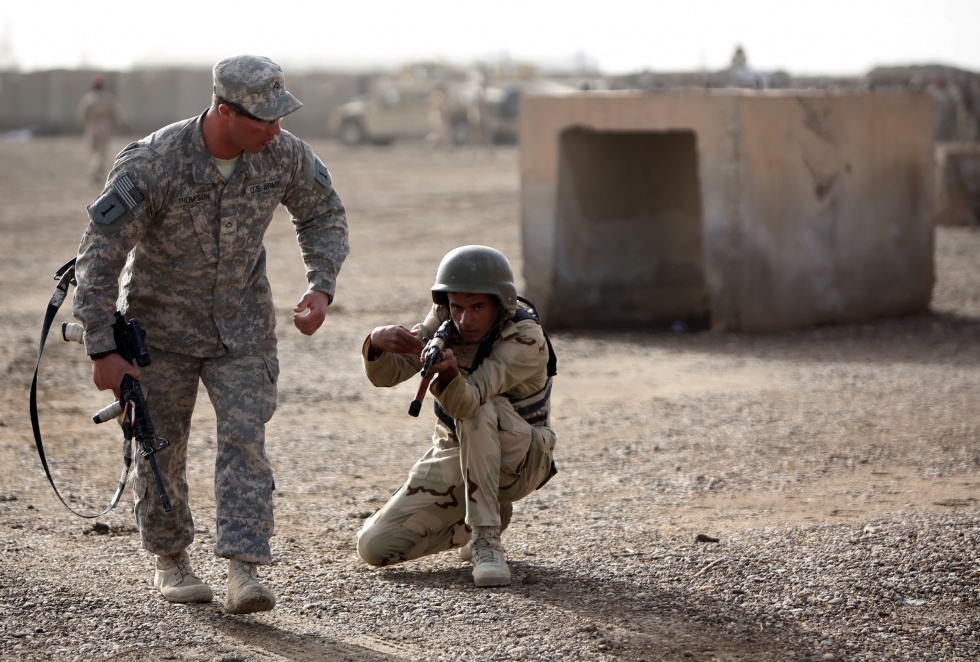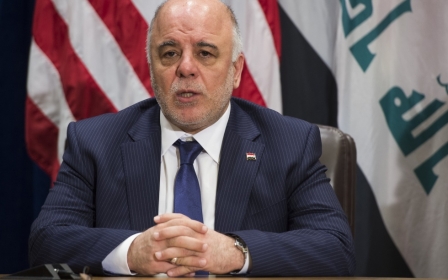US trains Iraqis for house-to-house battle against IS

A team of camouflage-clad Iraqi soldiers lines up near the door of a one-storey house north of Baghdad with rifles ready, preparing to enter and search it.
For now, there are no militants inside, and American and Iraqi instructors are on hand to tell them how to position themselves, where to look when they enter and how to hold their Kalashnikov assault rifles.
But these are skills the soldiers, who are some two weeks into a six-week training programme at the massive Taji base complex, may soon need to employ against foes who shoot back.
The Islamic State (IS) group led a sweeping militant offensive last June that overran large areas north and west of Baghdad, and multiple Iraqi divisions collapsed during the assault.
A US-led coalition is carrying out air strikes against IS, and is also providing training aimed at rebuilding the Iraqi forces and readying them to fight.
The aim is to eventually train 5,000 federal soldiers and Kurdish fighters at five sites every six to eight weeks -- a tight timeline, especially for newly recruited troops.
There are four Iraqi battalions, of roughly 400 soldiers each, being instructed in infantry skills at Taji by a combination of US and Iraqi trainers.
Around 80 more are receiving tank training.
Most are recent recruits who volunteered after the IS-led offensive began, knowing that they would likely see combat.
Before this course, they received just a few months of basic training.
Now they are being trained for the house-to-house fighting that will be necessary to recapture the cities, towns and villages that IS holds.
The recruits will have to make split-second distinctions between militants and civilians if they are to avoid casualties among residents whose support will be vital in the long run if IS is to be defeated.
Knowing how to approach, enter and clear a building are key skills that they will need.
The exercise begins with small teams of Iraqis rushing across open ground, going prone to avoid simulated enemy fire, then moving to take cover behind makeshift obstacles, including wooden doors.
Shortage of experienced leaders
The training programme is still in its infancy and some improvisation is necessary.
To mimic the sound of gunfire as the exercise unfolds, one American soldier has the unenviable task of repeatedly hitting a piece of metal with a hammer.
When they reach cover, the Iraqi soldiers are supposed to ready their assault rifles to fire -- saying "bang" to simulate shooting, as they are not using blank ammunition -- and then put the safeties back on before advancing again.
The second step is periodically forgotten, and US instructors yell "put your safety on" at the errant trainees, sometimes accompanied by profanity.
The Iraqi soldiers then reach the building they will clear and "stack," lining up one behind the other along the wall with rifles ready, before moving inside.
The exercise also includes simulated casualties, with some soldiers being declared "wounded" so others can practise battlefield first aid.
"It's really taking a lot of the training from throughout the last couple weeks and kinda combining them into an event that... brings it all together," says Captain David Neveau.
The units training at Taji have a shortage of experienced officers and non-commissioned officers, so they are being selected from the ranks during the course.
"From a newly formed unit, they don't really have a bunch of NCOs and a bunch of officers, so we're trying to pick leaders from the group," Neveau says.
There is training for officers focusing on leadership, but another aim is to spread responsibility down the ranks.
We "actually have some of the commanders off to the side... letting some of the soldiers take their squads and teams through," says Command Sergeant Major Tony Grinston, who is overseeing the training programme.
"We're just trying to take small steps so that when... a leader goes down, the mission continues," he says.
But the key question is whether the Iraqi army will continue the training after the course is over -- something that US soldiers say was not done after American forces departed in 2011.
"If you... teach them and then stopped doing it for a year or six months, you can't expect them to be good at it," Grinston says.
Samarra attacks on Shiite militia
Meanwhile, five car bomb explosions killed four fighters from al-Hashd al-Shaabi – a pro-government Iraqi Shiite militia – and wounded 35 others in northern Samarra, Iraq, according to a security source.
"Five suicide attackers drove their vehicles into Iraqi security forces and al-Hashd al-Shaabi factions and managed to kill four people and wound 35 others," a security source, who preferred not to divulge his name, told The Anadolu Agency.
The explosions occurred in the al-Haweesh area and the highway in Samarra. Iraqi security forces have taken security measures in preparation for any further attacks which may occur, the source added.
Samarra is a city in the northern province of Saladin with a Sunni majority, but two Shiite shrines in the city make it a destination for Shiite visitors.
Middle East Eye propose une couverture et une analyse indépendantes et incomparables du Moyen-Orient, de l’Afrique du Nord et d’autres régions du monde. Pour en savoir plus sur la reprise de ce contenu et les frais qui s’appliquent, veuillez remplir ce formulaire [en anglais]. Pour en savoir plus sur MEE, cliquez ici [en anglais].



